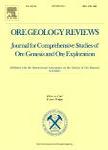版权所有:内蒙古大学图书馆 技术提供:维普资讯• 智图
内蒙古自治区呼和浩特市赛罕区大学西街235号 邮编: 010021

作者机构:Curtin Univ John de Laeter Ctr Kent St Bentley WA 6102 Australia Curtin Univ Inst Geosci Res TIGeR Kent St Bentley WA 6102 Australia Curtin Univ Sch Earth & Planetary Sci Kent St Bentley WA 6102 Australia Monash Univ Sch Earth Atmosphere & Environm Clayton Vic 3800 Australia Univ Edinburgh Sch Geosci Kings BldgJames Hutton Rd Edinburgh EH9 3FE Midlothian Scotland China Univ Geosci State Key Lab Geol Proc & Mineral Resources Beijing Peoples R China
出 版 物:《ORE GEOLOGY REVIEWS》 (矿物地质学评论)
年 卷 期:2020年第120卷
页 面:103448-103448页
核心收录:
学科分类:0819[工学-矿业工程] 0709[理学-地质学] 08[工学]
基 金:Thermo Fisher GSWA MRIWA ARC AuScope via NCRIS John de Laeter Centre, Curtin University via an Australian Geophysical Observing System grant Australian Research Council LIEF program [LE150100013]
主 题:Penzance Teutonic Bore Volcanic-hosted massive sulphide Archean Geochronology 4D modelling
摘 要:The Teutonic Bore Camp, comprised of the Teutonic Bore, Jaguar and Bentley deposits, is one of the most significant volcanic-hosted massive sulphide (VHMS) camps in Western Australia. Despite being extensively studied, only recently there have been advances in the understanding of the mechanism that drove the formation of mineralisation. It has been recognized by recent studies that the volcanic-hosted deposits from the Teutonic Bore Camp represent replacement-type VHMS systems, with significant input of fluids and metals from a magmatic source. This paper tests the existing hypothesis that the nearby Penzance granite acted as the metals source and/or thermal engine driving the development of these ore deposits. New age constraints on the formation of the host volcanic sequence at the Bentley deposit and the crystallization of the Penzance granite allows for the construction of a 4D evolutionary model for the ore system. A new U-Pb SHRIMP monazite age of 2681.9 +/- 4.5 Ma indicates that the Penzance granite post-dates the host stratigraphy at Bentley (ca. 2693 Ma) and is probably coeval with mineralisation. All zircons (Penzance, Bentley units I and III) have very similar epsilon Hf-(i), with most values between -1 and + 6, slightly higher than the epsilon Hf-(i) of zircons from other granites and volcanics within the Kurnalpi Terrain, and indicative of juvenile sources. The mean Th/U ratios are similar to 0.7 and similar to 0.6 for the Penzance and Bentley zircons, respectively. All zircons have similar Ce/Nd-(CN) ratios. The chemical similarities between the zircons from the granite and the volcanic rocks at Bentley support a shared magmatic source between the Penzance and the Teutonic Bore Camp sequence. The Penzance granite is the likely source of heat, and potentially metals, which drove the VHMS mineralisation at the Teutonic Bore Camp.